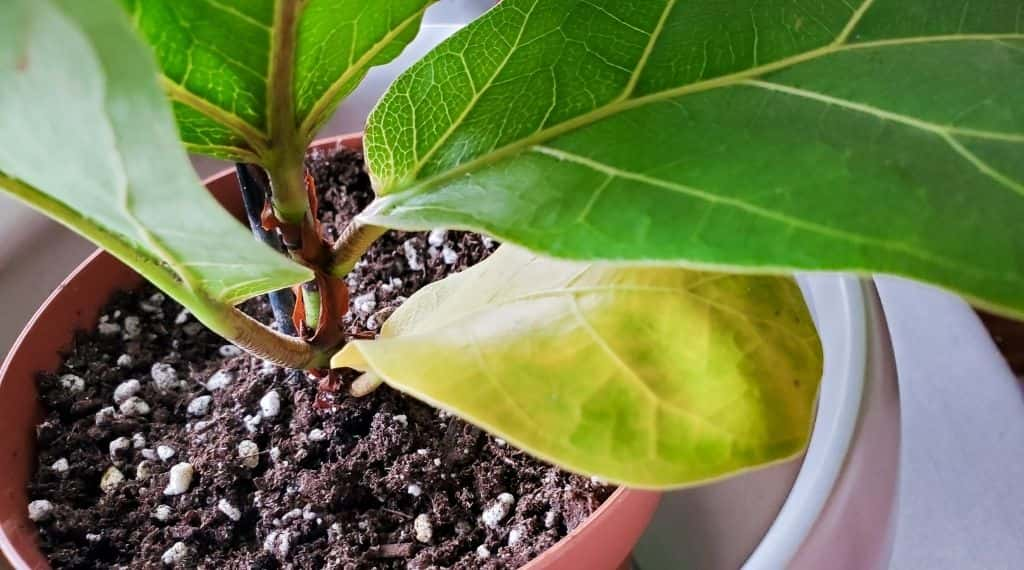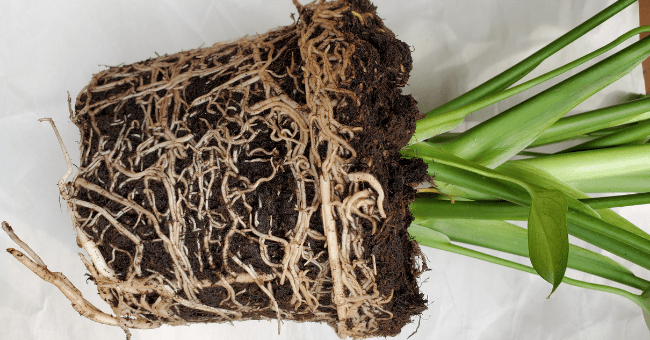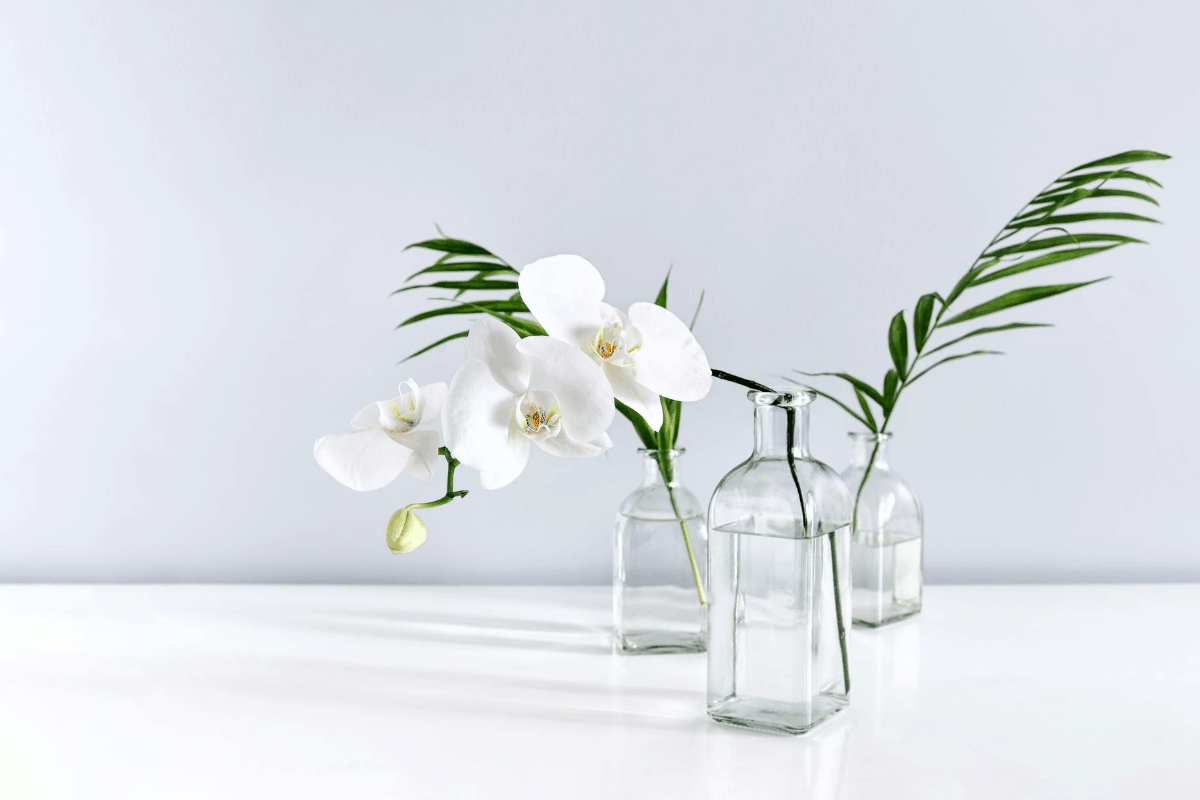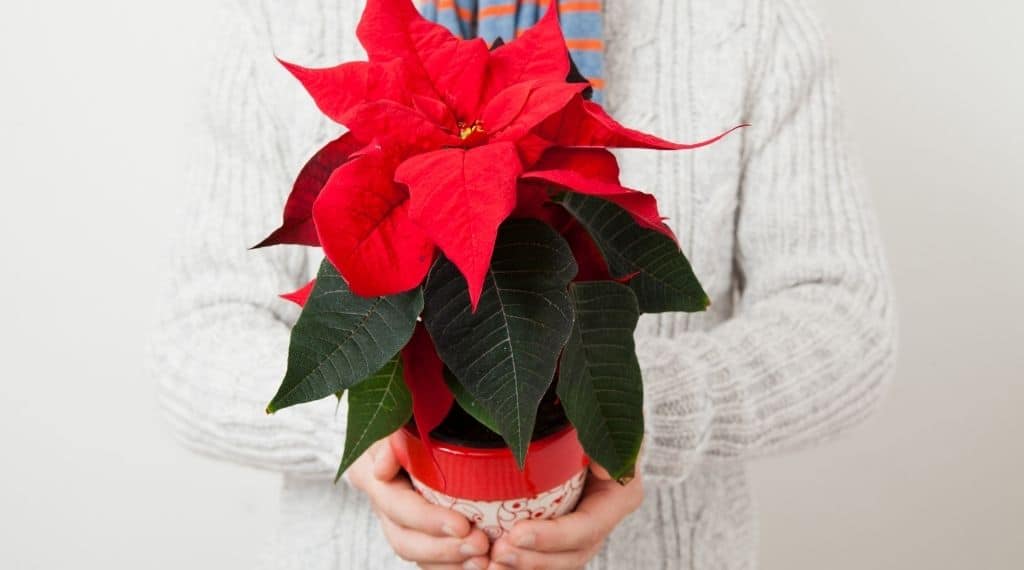Last Updated on October 5, 2021 by Plantiful Interiors
Help! Why is my houseplant turning yellow?
One of the most common concerns plant owners face is the dreaded yellow leaves. Understanding why houseplant leaves turn yellow, and knowing what to do when this happens, could be the difference between life and death for your little plant buddy.
Before you give up and toss your once lush green plant aside, let us first examine what causes plant leaves to turn yellow, and more importantly, how we can treat yellow leaves and return your plant to its former green leaf glory.
This site features affiliate content. As an affiliate partner of various brands, we earn commissions on qualifying purchases, at no extra cost to you. Please read our disclaimer for more information.
Why do plant leaves turn yellow?
There are 7 main reasons why your plant leaves are turning yellow. These include:
- not getting enough water
- getting too much water
- root bound
- too cold
- not getting enough light (or too much light)
- nutrient deficiency
- bugs
We’ll explore each of these causes in more detail below so that you’ll be able to determine the cause of yellow leaves on your indoor plants.
Not Getting Enough Water
Moisture stress is often the most common reasons why houseplant leaves turn yellow. Moisture stress can be caused by either underwatering or overwatering your houseplant.
The simplest way to find out if your plant lacks the correct amount of water is to push your finger in to the soil about 2 inches deep; if it’s dry it’s a sure sign that your plant hasn’t received sufficient water to maintain its pristine condition.
You can also often tell by the weight of your plant, if the container is very light to pick up, the soil is most likely dry as water will cause the pot to be heavier.
How To Treat Underwatered Plants
If your plant is underwatered, the best solution to rectify it is to water the plant more regularly. Plants typically need watered every 1-2 weeks, some even more frequently depending on the type and environment.
If like many people, you sometimes forget to water your plant as often as you should, set a reminder in your calendar. You could try matching this chore with something else you do. For example: Every Sunday after you brush your teeth, water your plants. You could even leave the watering can in your bathroom as a reminder.
Related Reading: Best Plant Moisture Meter
Too Much Water
On the other hand, too much water can cause just as many problems as underwatering. Over watering a plant is a common cause of yellow plant leaves. Soft brown stalks are also a good indication that overwatering has taken place.
Most times we overwater plants out of care and concern, not realizing the damage too much water can cause.
How To Treat Underwatered Plants
A simple solution to avoid overwatering is similar to solving the underwatering problem. Create a schedule that works for you. Also, measure the amount of water you use so you can use roughly the same amount each time.
If you’re finding the soil is drying out more frequently you could try moving it further from the light source, but where it will still get adequate light.
Ensure that your plant has sufficient drainage, this can be through drain holes in the bottom of your pot as well as the type of soil the plant is potted in.
Keep a watchful eye on your plant and only water when the soil is dry to the touch, ensuring you don’t allow the soil to dry out completely.
Plant Is Root Bound
If your plant has yellowing leaves near the bottom of the plant, this could be a sign that your plant does not have enough room to grow.
When your plant roots have taken up all the space within its container, you have what’s known as a root bound plant on your hands.
The mass tangle of roots can form a hard compacted ball that causes a plant to be pushed upwards and out of its pot. Because a web of roots has replaced the potting soil, your plant can become stressed, depriving it of essential nutrients, causing its leaves to turn yellow.
The only way to know for certain if your plant is root bound is to remove the plant from the pot and inspect the roots. If the roots are matted around the rootball, this is a positive sign that your plant is root bound and needs more room to grow or needs to be pruned.
How To Treat Root Bound Plants
You have two options when root bound occurs.
- prune the plant’s roots
- repot your plant into a larger container
Pruning Your Plant’s Roots
If you don’t wish for your plant to grow any larger or don’t have a bigger pot available, you can prune your plants’ roots. The procedure is not as complicated as it may sound, assuming your plant isn’t too big.
Firstly, you’ll need to get the plant out of its pot. To do this, without causing too much stress or damage to your plant, lightly massage the sides of the pot pressing gently to loosen up the soil inside, allowing your plant to come out freely and in tact.
You’ll need a clean pair of sharp scissors, pruners, or a knife.
Here’s a quick video demonstration that will walk you through how to prune the roots of your potted plant.
Once we’ve finished pruning the outer thread leaves we like to gently loosen the soil so that the roots start to untangle and dangle. This will help the roots to expand into the potting soil rather than in circles, which could strangle your plant. You’re now ready to repot your plant.
Repotting Your Plant
Moving your plant into a container one size up will enable the roots to expand, allowing your plant to continue its growth. It’s recommended that you only increase your pot size by 2 inches at a time. Follow repotting instructions specific to your plant for best results.
Take enough potting soil to ensure your smaller root ball sits on the soil with the top of the plant about one inch below the container’s edge. Once you’ve placed your plant into the pot, you’ll need to place soil around the sides while gently pressing down, making sure to fill all the voids and not leave any gaps.
After you finish repotting your plant give it a a bit of water. Keep your plant well hydrated (without overwatering) for the next few weeks and you shouldn’t see any more yellow leaves.
You May Also Enjoy: What Is The Best Potting Soil for Indoor Plants
Temperature is Too Cold
Drafty areas within a home are not uncommon, with the usual suspects being doors, windows, outlets, light fixtures, and chimneys.
Tropical plants enjoy warm temperatures. If you notice your plant’s leaves are turning yellow, check to see if they are situated near any cold drafts. Drafts are a common cause of yellowing plant leaves and can be especially hard on your plant when the sun goes down.
If it’s summer time and your plant is placed directly near an air conditioner where it is exposed to cold temperatures regularly, you’re more likely to see the leaves turn brown.
How To Treat Yellow Leaves Due To Cold Temperatures
Your plant’s positioning is important if you want to avoid any problems associated with cold currents of air.
Keep your plant away from windows known for causing drafts and ensure your plants are not placed next to vents or doors that are continually being opened and closed.
You May Also Enjoy: How & When Can I Move Houseplants Outside Without Killing Them
Improper Light Conditions Causing Yellow Leaves
If you notice the leaves on your plant are only turning yellow on one side, it’s a good chance that lighting is the cause of the problem, or in this case, the lack of it.
Plants placed on windowsills in direct sunlight can often fall victim to improper lighting. You’ll likely notice the side of your plant that faces the window is blessed with vibrant green leaves while the opposite side is starved of such beauty and is instead the benefactor of jaundice looking leaves. This is because the leaves facing the window are getting all the sun’s benefits while blocking the light from the opposite side.
How To Treat Improper Lighting Conditions for Plants
The resolution for improper lighting is easy. Simply rotate your plant once or twice a week to ensure all sides get their fair share of the sun’s natural light.
You could also, of course, try and place it in a sunnier position where light can reach all angles. If this is not possible because your property lacks a sufficient amount of natural light, you may need to invest in an artificial plant light.
Nutrient Deficiency
If the leaves at the top half of your plant are turning yellow, this is a good indication that your houseplant lacks the essential nutrients it needs to thrive.
Other signs relating to these problems could be strange patterns related to the yellowing, such as the veins on the leaves being green while the tissue is yellow.
A nitrogen deficiency could cause such problems, or there could be too much calcium in the water supply, especially if you live in a hard water area.
How To Treat Nutrient Deficiency
All plants are different, as are their needs, some being more particular than others.
Without knowing first where the problem lies, it would be foolish to treat a plant as you could easily destroy it.
Invest in an at-home soil testing kit. Using one of these will give you an excellent indication of your plant’s requirements and needs.
Bugs
Spots and smears of color residing on crinkled yellow leaves could be an indication that your plant has been invaded by ravenous insects that want to devour the sap from your plant.
The most common pest for both indoor and outdoor plants is the Aphid. Curling, wilting yellow leaves and stunted growth are a sign that these yellow, red, or black bugs are to blame.
How To Treat Bug Infested Houseplants
Treating a plant that has bugs can be a little tricky. First, you’ll want to try and figure out what type of bugs you’re dealing with. If they are soft-bodied bugs such as mealybugs, whiteflies or spider mites, spraying them with a homemade insecticidal soap. Spray the mixture on your plant once per week to control the issue.
If there are bugs flying around your plant, use sticky stakes to trap and kill the bugs. This will help prevent the bugs from moving to other plants within the house.
You May Also Enjoy: 5 Proven Techniques For Getting Rid of Fungus Gnats
Your Plants Need Your Attention
Your houseplant’s life is in your hands. When it falls ill, it needs your tender loving care. If it’s plagued with pests, it expects you to remove them. If it lacks essential nutrients, you’re the one who can supply them.
It’s you and only you who decide how much sunlight your plant gets and whether it’s positioned away from cold spots and drafts. Nobody else decides how often your plant should be watered, and your plant is reliant on you to untangle the web of roots when it’s rootbound.
If you follow all the advice, you can be assured; your houseplant is also in safe hands and now that you know why houseplants leaves turn yellow and what to do about them you’re much better equipped to keep your plants healthy.
FAQ – Yellow Plant Leaves
Can yellow leaves turn green again?
It’s unlikely that your plant’s yellow leaves will ever return to being green unless the diagnosis is a nutrient deficiency. In which case, supplying it with the nutrients it needs will likely see them return to its natural color. But even if those yellow leaves never regain that lush color, it’s not the end of the world, far from it.
Will plants with yellow leaves die?
Yellow leaves on a plant does not mean your plant will die. A quick diagnosis and prompt action can easily save your plant from the great garden in the sky. When you first notice that your plant has run into trouble, it’s time to act. Don’t just leave it thinking it will regain its former glory on its own. The likelihood is it won’t, and the chances are it will die. Yellowing leaves can be caused by a number of problems, some of which we have discussed. As long as you treat your plant as soon as you see the signs, there’s every chance your plant will survive.




